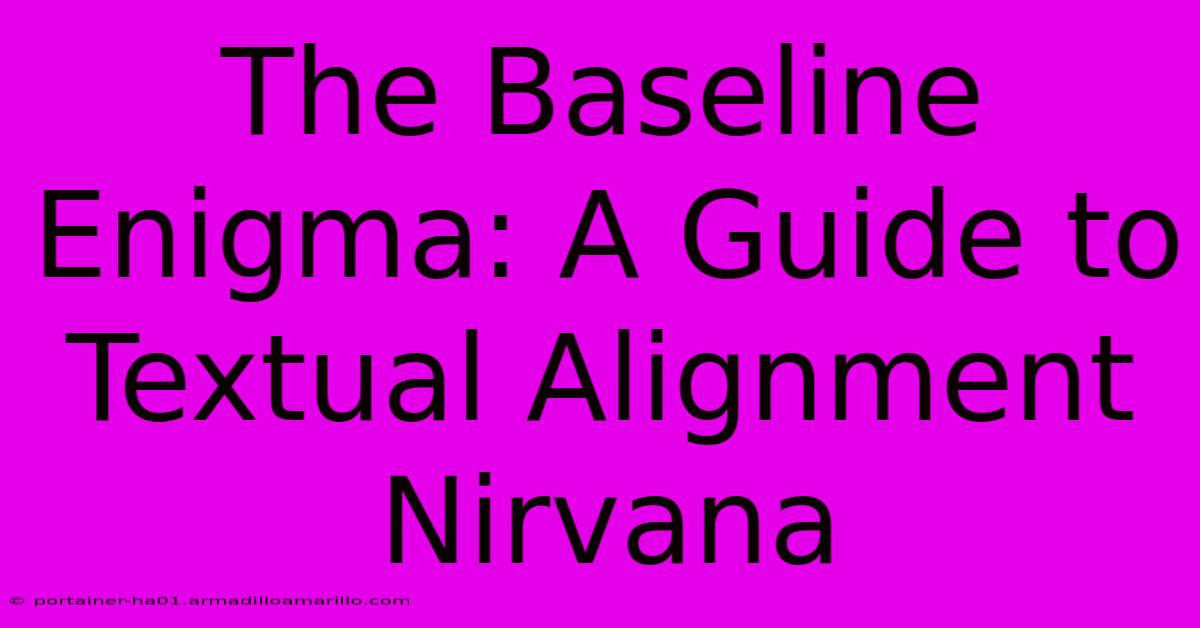The Baseline Enigma: A Guide To Textual Alignment Nirvana

Table of Contents
The Baseline Enigma: A Guide to Textual Alignment Nirvana
Achieving perfect textual alignment can feel like solving a cryptic puzzle. But understanding the "baseline enigma"—the invisible line that governs text placement—is key to creating clean, professional, and aesthetically pleasing designs. This guide unravels the mysteries of baseline alignment, offering practical tips and techniques to achieve textual alignment nirvana.
What is Baseline Alignment?
Baseline alignment refers to the invisible horizontal line upon which characters in a line of text sit. It's the foundation of typographic harmony. Think of it as the unseen ruler that dictates the vertical positioning of all your text, ensuring consistent spacing and a visually pleasing arrangement. Proper baseline alignment creates a sense of order and professionalism, making your text easily readable and visually appealing. Improper alignment, on the other hand, can create a messy and unprofessional appearance.
Understanding the Importance of Consistent Baselines
Why bother with this seemingly minor detail? Because inconsistent baselines are jarring to the eye. They disrupt the visual flow of your text, making it harder to read and diminishing the overall impact of your design. Maintaining consistent baselines is crucial for:
- Readability: Consistent baselines improve readability by creating a clear and even visual rhythm.
- Professionalism: Proper alignment projects a sense of care and attention to detail.
- Aesthetic Appeal: A well-aligned text block is simply more pleasing to look at.
Common Baseline Alignment Issues
Before diving into solutions, let's identify some common problems:
1. Mixing Fonts Inconsistently
Using different fonts with varying x-heights (the distance between the baseline and the meanline of lowercase letters) can lead to misaligned baselines. Make sure your font choices are compatible, or use consistent font families.
2. Incorrect Line Spacing
Improper line spacing (leading) can shift baselines, resulting in uneven text blocks. Ensure your line spacing complements your font choice and maintains consistent vertical spacing.
3. Using Images or Other Elements Incorrectly
Placing images or other design elements without considering baseline alignment can disrupt the visual harmony of your text. Carefully position elements to respect the baseline grid.
Achieving Baseline Alignment Nirvana: Practical Tips
Now, let's tackle the practical aspects of achieving perfect alignment:
1. Utilize a Grid System
A well-defined grid system acts as a framework for consistent baseline alignment. By aligning your text to the grid, you ensure uniformity and a professional appearance. Many design software programs offer grid functionalities to aid in this process.
2. Leverage Design Software Features
Most professional design software packages (like Adobe InDesign, Photoshop, Illustrator, Figma, and others) have features specifically designed to control and align baselines. Explore these options and master their usage for precise alignment. Learn to use tools that show baselines directly, allowing you to visually check alignment.
3. Pay Attention to Font Metrics
Understanding font metrics, including x-height, cap height, and ascenders/descenders, is crucial for achieving precise baseline alignment, particularly when mixing fonts. Use these metrics to guide your spacing and alignment decisions.
4. Check Your Work Carefully
Always proofread and visually inspect your work. Zoom in to check for any inconsistencies. Even a small misalignment can disrupt the overall appearance.
Beyond the Basics: Advanced Techniques
For advanced users, consider these techniques:
- Baseline Grids in CSS: For web design, understanding and utilizing CSS baseline grids allows for consistent alignment across different browsers and devices.
- Optical Alignment: While mathematical precision is important, sometimes "optical alignment" is necessary. This involves fine-tuning alignment based on visual perception, adjusting for optical illusions that can subtly affect the perceived alignment.
Conclusion: The Path to Textual Harmony
Mastering baseline alignment is a journey, not a destination. By understanding its importance, recognizing common issues, and applying the techniques outlined here, you can elevate your designs and achieve textual alignment nirvana. Remember, consistent baselines are the foundation of clean, professional, and aesthetically pleasing typography. The reward for paying attention to this often-overlooked detail is a significant improvement in the overall quality of your work.

Thank you for visiting our website wich cover about The Baseline Enigma: A Guide To Textual Alignment Nirvana. We hope the information provided has been useful to you. Feel free to contact us if you have any questions or need further assistance. See you next time and dont miss to bookmark.
Featured Posts
-
Checkmate Create An Invitation For A Chess Inspired Birthday Bonanza
Feb 07, 2025
-
Drive Your Fonts Into The Fast Lane Unleash The Porsche Sans Charm
Feb 07, 2025
-
Unleash The Feline Fury Cat Eye Nail Polish For A Mesmerizing Gaze
Feb 07, 2025
-
Decoded The Spectral Symphony Of Redemption In Bible Colors
Feb 07, 2025
-
Gold Vermeil Bracelets The Ultimate Symbol Of Style And Sophistication
Feb 07, 2025
